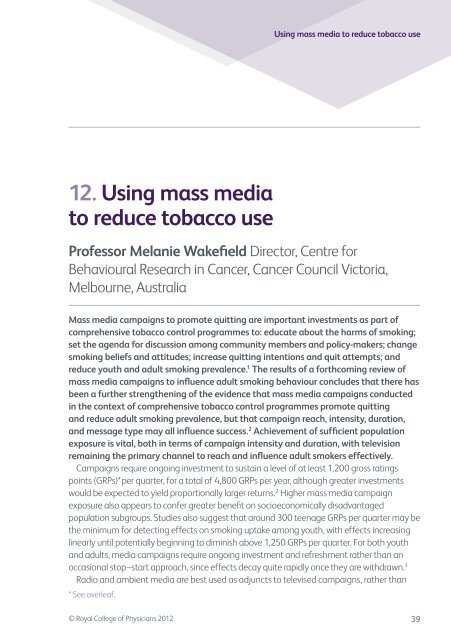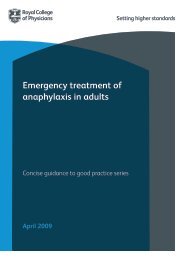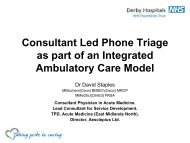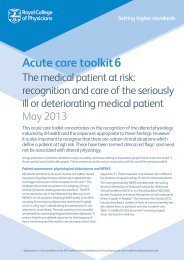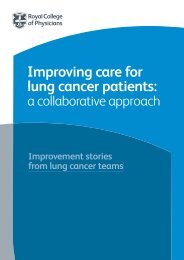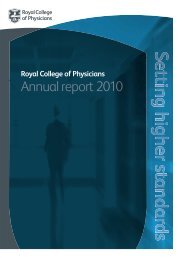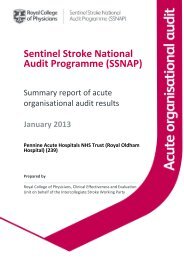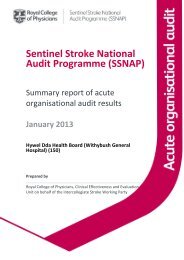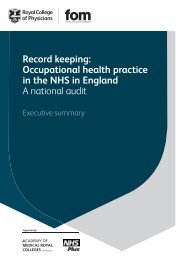Fifty years since Smoking and health - Royal College of Physicians
Fifty years since Smoking and health - Royal College of Physicians
Fifty years since Smoking and health - Royal College of Physicians
Create successful ePaper yourself
Turn your PDF publications into a flip-book with our unique Google optimized e-Paper software.
12. Using mass media<br />
to reduce tobacco use<br />
Pr<strong>of</strong>essor Melanie Wakefi eld Director, Centre for<br />
Behavioural Research in Cancer, Cancer Council Victoria,<br />
Melbourne, Australia<br />
Mass media campaigns to promote quitting are important investments as part <strong>of</strong><br />
comprehensive tobacco control programmes to: educate about the harms <strong>of</strong> smoking;<br />
set the agenda for discussion among community members <strong>and</strong> policy-makers; change<br />
smoking beliefs <strong>and</strong> attitudes; increase quitting intentions <strong>and</strong> quit attempts; <strong>and</strong><br />
reduce youth <strong>and</strong> adult smoking prevalence. 1 The results <strong>of</strong> a forthcoming review <strong>of</strong><br />
mass media campaigns to infl uence adult smoking behaviour concludes that there has<br />
been a further strengthening <strong>of</strong> the evidence that mass media campaigns conducted<br />
in the context <strong>of</strong> comprehensive tobacco control programmes promote quitting<br />
<strong>and</strong> reduce adult smoking prevalence, but that campaign reach, intensity, duration,<br />
<strong>and</strong> message type may all infl uence success. 2 Achievement <strong>of</strong> suffi cient population<br />
exposure is vital, both in terms <strong>of</strong> campaign intensity <strong>and</strong> duration, with television<br />
remaining the primary channel to reach <strong>and</strong> infl uence adult smokers effectively.<br />
Campaigns require ongoing investment to sustain a level <strong>of</strong> at least 1,200 gross ratings<br />
points (GRPs)* per quarter, for a total <strong>of</strong> 4,800 GRPs per year, although greater investments<br />
would be expected to yield proportionally larger returns. 2 Higher mass media campaign<br />
exposure also appears to confer greater benefi t on socioeconomically disadvantaged<br />
population subgroups. Studies also suggest that around 300 teenage GRPs per quarter may be<br />
the minimum for detecting effects on smoking uptake among youth, with effects increasing<br />
linearly until potentially beginning to diminish above 1,250 GRPs per quarter. For both youth<br />
<strong>and</strong> adults, media campaigns require ongoing investment <strong>and</strong> refreshment rather than an<br />
occasional stop–start approach, <strong>since</strong> effects decay quite rapidly once they are withdrawn. 3<br />
Radio <strong>and</strong> ambient media are best used as adjuncts to televised campaigns, rather than<br />
* See overleaf.<br />
Using mass media to reduce tobacco use<br />
© <strong>Royal</strong> <strong>College</strong> <strong>of</strong> <strong>Physicians</strong> 2012 39


